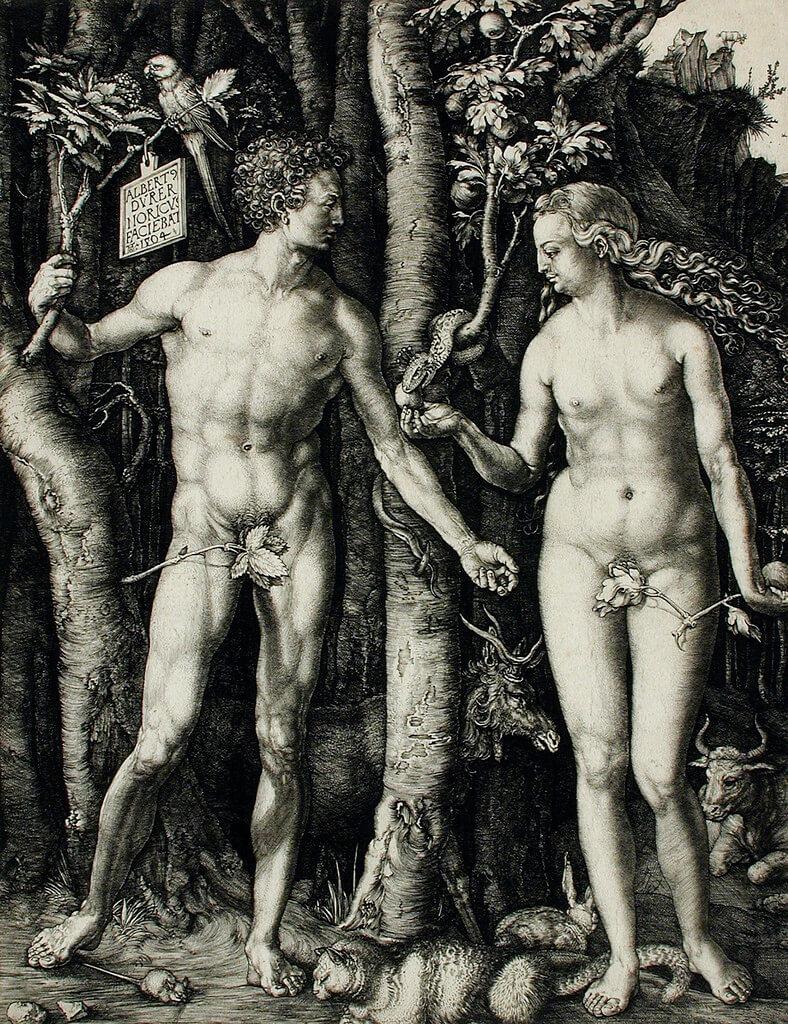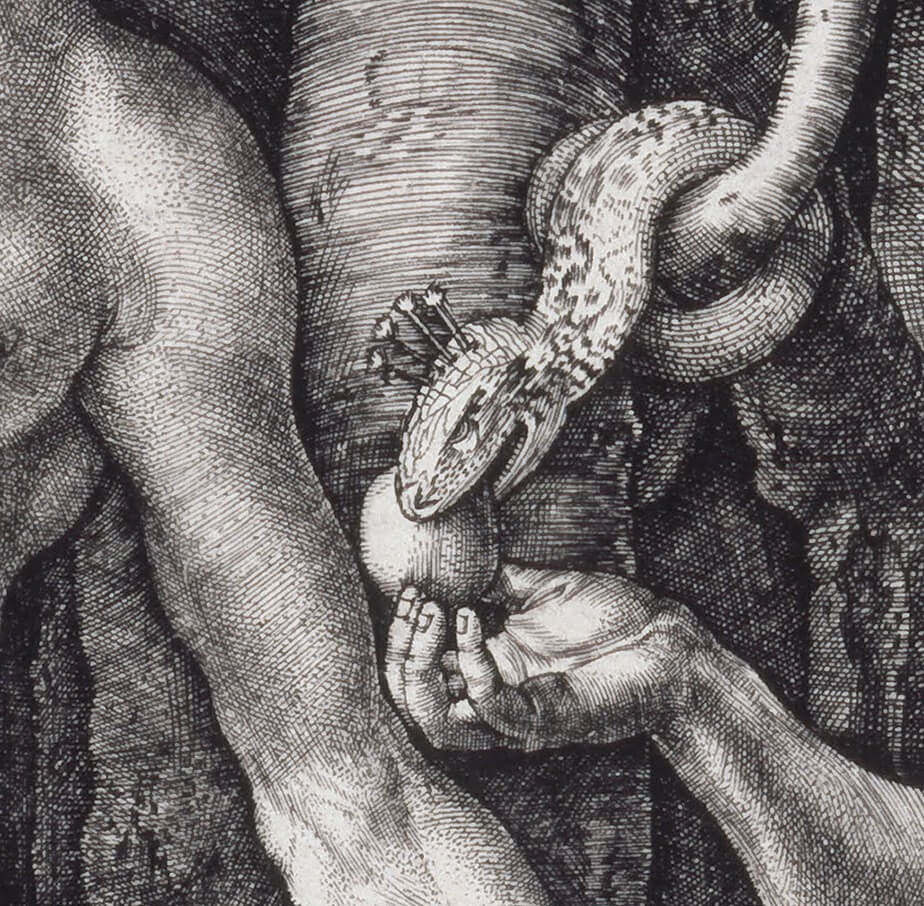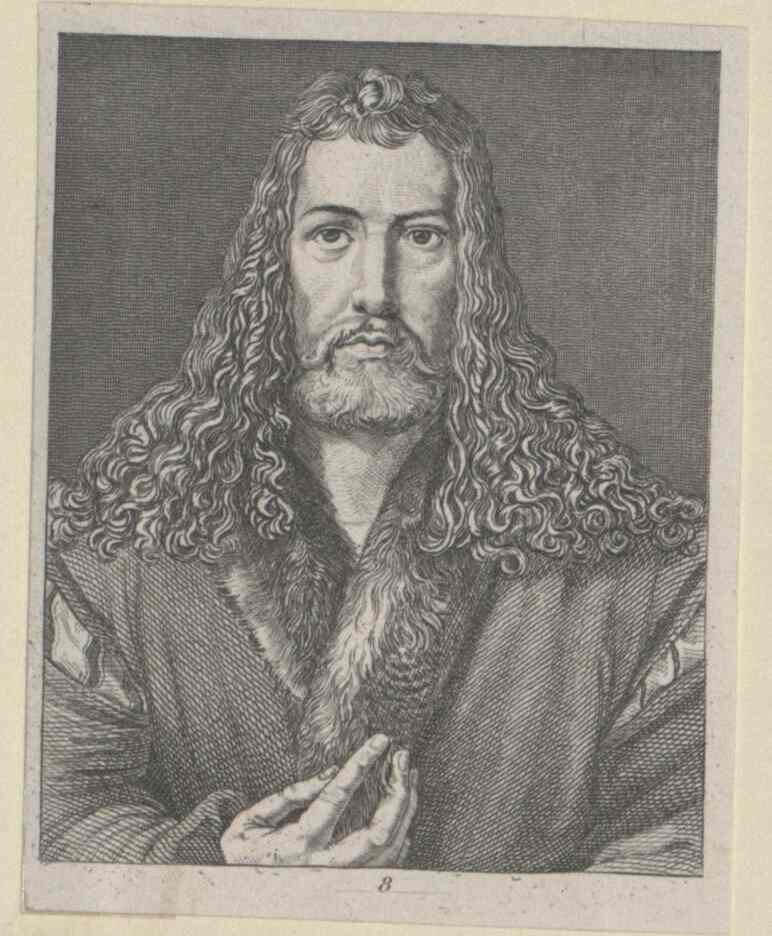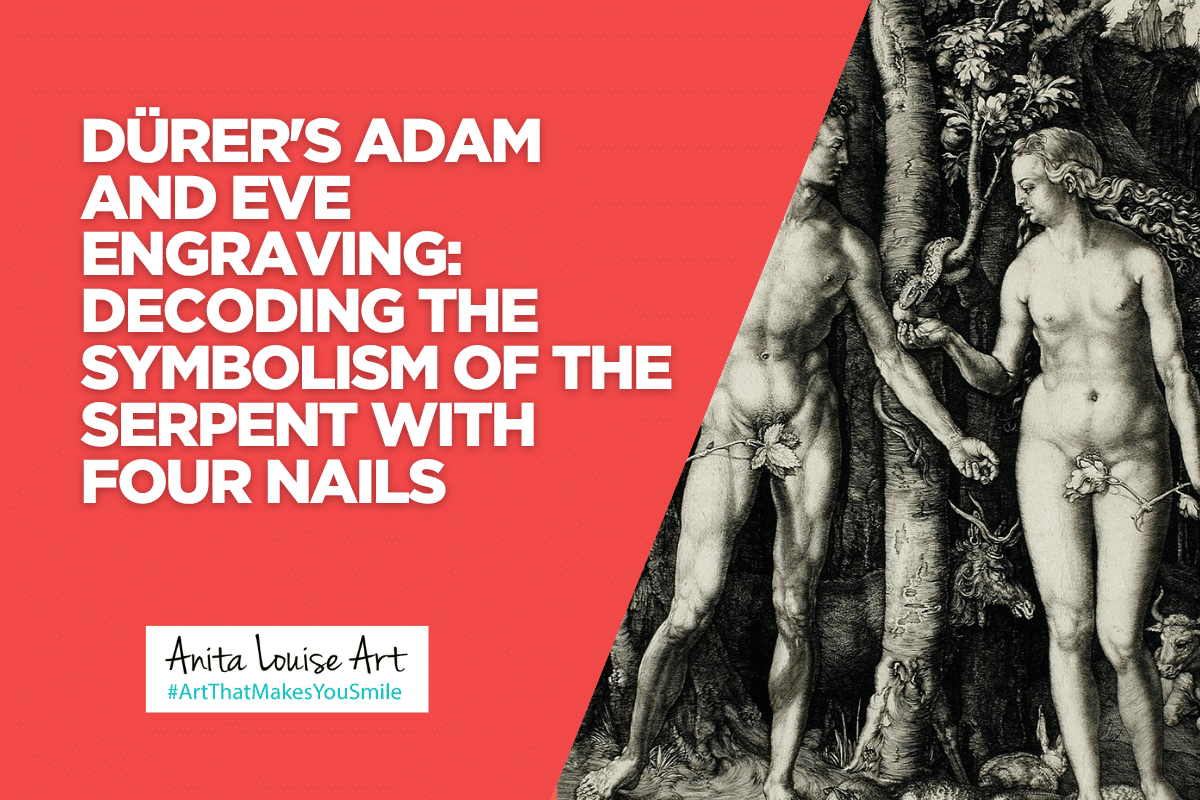Albrecht Dürer’s 1504 engraving “Adam and Eve” stands as one of the most significant works of the Northern Renaissance, a masterpiece that continues to captivate viewers more than five centuries after its creation.
This meticulous copper engraving showcases not only Dürer’s technical virtuosity but also his profound engagement with theological concepts, classical knowledge, and Renaissance humanism. Among the many symbolic elements embedded within this composition, the serpent with four nails in its head represents a particularly fascinating detail that merits closer examination. This seemingly minor feature encapsulates multiple layers of Christian symbolism, connecting the Fall of Man with the promise of redemption through Christ.
Table of Contents
- Albrecht Dürer: Renaissance Master of the North
- The Engraving: A Technical Marvel
- The Serpent with Four Nails: Layers of Meaning
- Beyond the Serpent: Other Symbolic Elements
- Dürer’s Theological Vision
- The Engraving’s Legacy and Influence
- A Masterpiece of Visual Theology
- Deep Dive Podcast
- Related Content
Read on as we explore the rich tapestry of symbolism in Dürer’s “Adam and Eve,” focusing particularly on the enigmatic four-nailed serpent while also examining the broader symbolic language that makes this work a cornerstone of Renaissance art history.

Albrecht Dürer: Renaissance Master of the North
Before delving into the symbolism of the engraving, it’s worth understanding the artist himself. Albrecht Dürer (1471-1528) emerged as the preeminent artist of the German Renaissance, bridging Northern European artistic traditions with Italian Renaissance innovations.
Born in Nuremberg to a goldsmith father, Dürer received training that gave him exceptional precision in detailed work—a skill that would serve him well in the demanding medium of engraving.
Dürer’s two journeys to Italy exposed him to the artistic developments of the Italian Renaissance, including the study of human proportions, perspective, and classical themes. He was among the first Northern European artists to fully embrace Renaissance humanist ideals while maintaining the meticulous detail and symbolic richness characteristic of Northern European art.
By 1504, when he created “Adam and Eve,” Dürer had established himself as a master printmaker whose works circulated throughout Europe, spreading his reputation and artistic influence far beyond his native Germany.
The Engraving: A Technical Marvel
“Adam and Eve,” also known as “The Fall of Man,” represents the pinnacle of Dürer’s engraving technique. Created by incising lines into a copper plate with a burin, then inking the plate and pressing it onto paper, the medium demanded extraordinary precision and foresight, as mistakes could not easily be corrected.
The composition shows the first human couple at the moment of temptation in the Garden of Eden. Eve receives the forbidden fruit from the serpent coiled around the Tree of Knowledge, while Adam reaches out to take it from her hand.
Around them, Dürer has placed animals representing the four temperaments of medieval medical theory: the rabbit (sanguine), the cat (choleric), the elk (melancholic), and the ox (phlegmatic). The background depicts the lush paradise of Eden, rendered with botanical precision.
What makes this work revolutionary is Dürer’s application of classical ideals of human proportion. Based on his studies of ancient sculpture and contemporary Italian art theory, the figures of Adam and Eve represent the artist’s conception of perfect human forms—the first truly classical nudes in Northern European art.

The Serpent with Four Nails: Layers of Meaning
At the heart of the composition is the serpent—not merely a snake, but a creature with a human-like face and, most curiously, four nails protruding from its head. This detail, easily overlooked by casual observers, carries profound theological significance.
1. The Protoevangelium and Christ’s Victory
The four nails in the serpent’s head directly reference Genesis 3:15, known as the “protoevangelium” or first gospel:
And I will put enmity between thee and the woman, and between thy seed and her seed; it shall bruise thy head, and thou shalt bruise his heel.
Genesis 3:15
This passage was interpreted by Christian theologians as the first prophecy of Christ’s eventual victory over Satan.
By placing four nails in the serpent’s head, Dürer creates a visual connection between the Fall and the Crucifixion.
The nails foreshadow Christ’s sacrifice on the cross, where tradition held that four nails were used (one for each hand and foot).
Thus, even in this scene of humanity’s fall from grace, Dürer includes a symbol of the redemption to come—the very instruments of Christ’s suffering already symbolically embedded in the head of the tempter.
2. The Four Temperaments and Human Nature
Dürer, like many Renaissance thinkers, was deeply interested in the theory of the four humors or temperaments: sanguine (blood), choleric (yellow bile), melancholic (black bile), and phlegmatic (phlegm). These were believed to determine human personality and health.
The four nails may represent how sin affects all four aspects of human nature. This interpretation gains strength when we consider that Dürer has already included animals representing each temperament in the composition.
The nails in the serpent’s head suggest that the Fall corrupted all dimensions of human experience.
3. The Four Elements and Cosmic Order
Renaissance Neo-Platonism often connected the four temperaments with the four elements: earth, air, fire, and water.
By including the four-nailed serpent, Dürer may be suggesting that the Fall disrupted the harmony of the entire created order, not just human nature.
4. The Four Evangelists and Redemptive History
Another layer of symbolism connects the four nails to the four Evangelists—Matthew, Mark, Luke, and John—whose gospels would record Christ’s victory over sin and death. This creates a narrative arc from the Fall to Redemption, suggesting that even at the moment of humanity’s first sin, God’s plan for salvation was already in motion.

Beyond the Serpent: Other Symbolic Elements
While the serpent with four nails forms a fascinating focal point, Dürer’s engraving contains numerous other symbolic elements that contribute to its theological richness:
The Tree of Knowledge and the Tree of Life
The central tree around which the serpent coils is the Tree of Knowledge of Good and Evil. However, Dürer has included various other trees in the background, one of which represents the Tree of Life—the other significant tree mentioned in Genesis.
This creates a visual tension between mortality (introduced by eating from the Tree of Knowledge) and the immortality that was denied to humanity after the Fall.
Perfect Human Proportions
Adam and Eve are depicted according to classical ideals of human proportion, reflecting Dürer’s belief that perfect human form revealed divine design.
Adam’s body follows the proportional ratio of 1:10 (head to body), which Dürer considered the ideal male proportion, while Eve’s follows a 1:9 ratio, his ideal for females. This mathematical precision reflects Renaissance beliefs about divine harmony expressed through numerical relationships.
The Animals and the Four Humors
As mentioned earlier, the animals represent the four temperaments: the rabbit (sanguine), the cat (choleric), the elk (melancholic), and the ox (phlegmatic).
Before the Fall, these temperaments existed in perfect balance; after the Fall, they would become imbalanced, leading to human suffering and disease.
The Mountain Goat: Steadfastness in Faith
Perched on a cliff in the background is a mountain goat, a symbol of the faithful who remain steadfast despite precarious spiritual circumstances. This represents those who, despite the Fall, would maintain faith in God’s promises.
The Parrot: The Virgin Birth
A parrot appears in the tree above the scene—a bird associated in Renaissance symbolism with the Virgin Mary, as it was believed parrots could reproduce without mating. This foreshadows Christ’s virgin birth, another element of the redemption story.
Dürer’s Theological Vision
Dürer was not merely an artist but a theological thinker deeply engaged with the religious currents of his time.
Living during the early years of the Protestant Reformation, he maintained connections with both Catholic and Protestant theologians. His work reflects a sophisticated understanding of Christian doctrine and an ability to translate complex theological concepts into visual form.
The “Adam and Eve” engraving embodies a distinctly Renaissance approach to Christianity—one that harmonized classical learning with Christian theology. By depicting the first humans with idealized classical proportions while surrounding them with medieval Christian symbolism, Dürer creates a synthesis that epitomizes Renaissance humanism’s reconciliation of ancient wisdom with Christian revelation.
The Engraving’s Legacy and Influence
Dürer’s “Adam and Eve” had an immediate and lasting impact on European art. As an engraving, it could be reproduced in multiple copies and circulated widely, spreading Dürer’s artistic innovations throughout Europe.
Artists from Italy to the Netherlands studied and emulated his approach to human anatomy, his technical precision, and his integration of symbolism.
The work also influenced theological visual culture, establishing a template for depicting the Fall that balanced naturalistic human forms with rich symbolic content. It demonstrated how Renaissance artists could address biblical subjects with both classical ideals and Christian symbolism.
A Masterpiece of Visual Theology
Dürer’s “Adam and Eve” engraving represents far more than a biblical illustration. It stands as a visual theological treatise that connects the beginning of human sin with its ultimate remedy in Christ. The serpent with four nails serves as the linchpin of this theological narrative, linking the Fall directly to the Crucifixion and Redemption.
What makes Dürer’s approach so powerful is his ability to layer multiple meanings within a single image. The four nails simultaneously evoke the Crucifixion, the four temperaments, the four elements, and the four Evangelists—creating a rich symbolic texture that rewards contemplative viewing.
In this masterwork, Dürer achieved what the greatest Renaissance artists sought: a perfect fusion of technical skill, classical knowledge, and Christian faith.
The engraving continues to speak to viewers today, not only as a testament to Dürer’s artistic genius but as a profound meditation on human nature, sin, and the promise of redemption. The serpent with its four nails reminds us that even in depicting humanity’s darkest moment, Dürer found a way to include a promise of hope—the very instruments of suffering transformed into symbols of salvation.
Through works like “Adam and Eve,” Dürer proved himself not just a master craftsman but a visual theologian whose insights continue to illuminate the central narratives of Western culture five centuries after his burin first touched copper.
Deep Dive Podcast
Learn more about this art work in our Deep Dive Podcast
Anita Louise Art is dedicated to art education, great artists, and inspiring others to find and create their art. We love art that uplifts and inspires. #ArtToMakeYouSmile! #ArtToMakeYouHappy!
If you want to see any of my art, you can find out more by clicking here. If you are interested in what inspires me and my paintings, you can discover more by clicking here.
We have a free newsletter and would love you to be part of our community; you can subscribe to the newsletter by clicking here. If you have any questions, I would be happy to talk to you. You can reach me, Anita, by clicking here.
Subscribe to our Anita Louise Art YouTube Channel with great videos and information by clicking here.
Join us for our podcast “5 Minutes With Art.” Spend just 5 minutes a week with us to discover and learn about great art and artists. You can find out more about our podcast by clicking here.
Related Content
Frida Kahlo’s Death And Life Of Pain On The Canvas Explored
Frida Kahlo passed away in 1954, approximately a year after undergoing the amputation of her right leg. Even in death, her life is shrouded in mystery as rumors circulate about the actual cause of her passing. Continue reading to delve deeper into the art, life, and enigmatic death of Frida Kahlo.
By clicking here, you can discover more by reading Frida Kahlo’s Death And Life Of Pain On The Canvas Explored.
Frida Kahlo’s Accident: How The Bus Tragedy Changed Her Life
At age 18, on the verge of fulfilling her dreams of becoming a doctor, Kahlo’s path took an unforeseen and tumultuous turn. September 17, 1925, marked the fateful day when a bus accident forever changed the trajectory of her existence, leaving her with profound physical and emotional scars. Little did she know that this transformative event would ignite the flame of her artistic journey, infusing her creations with an unparalleled depth and forging a unique and memorable art style that would captivate the world.
By clicking here, you can learn more by reading Frida Kahlo’s Accident: How The Bus Tragedy Changed Her Life.
Salvador Dali And Frida Kahlo, Similarities And Differences Explored
Salvador Dalí was a Spanish surrealist artist known for his melting clocks and dreamlike landscapes. Frida Kahlo was a Mexican painter known for her self-portraits that often depicted her physical pain and emotional turmoil. Both artists were highly influential and made significant contributions to the art world, but their styles and approaches to art were quite different.
By clicking here, you can learn more by reading Salvador Dali And Frida Kahlo, Similarities And Differences Explored.

